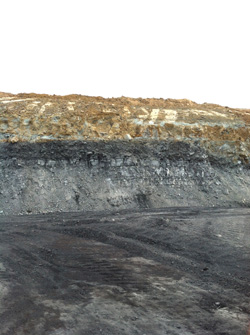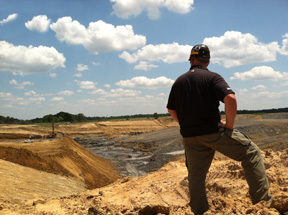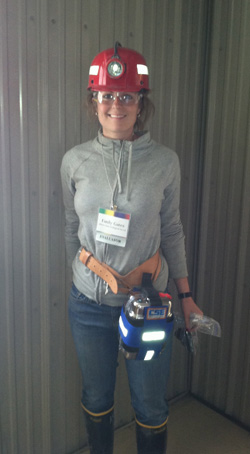I-STEM Evaluators Visit Coal Mines to Evaluate Coal Education Program

Lizanne DeStefano suited up in miner's gear to visit a coal mine.
July 10, 2012
Neither rain, nor sleet, nor snow, nor gloom of coal mine can keep an evaluator from her appointed rounds.
With this slight adaptation, the mail carrier's creed might apply to the dedication of I-STEM evaluators. For instance, Lizanne DeStefano, the Director of I-STEM rode for 45 minutes in a truck traveling three and a half miles down into a coal mine. Luckily she didn't have to ride on the back of a flat-bed truck like the miners do.
As part of an evaluation they conducted for the Department of Commerce and Economic Opportunity's (DCEO) Coal Education Program, DeStefano and I-STEM Research Associate Emily Gates attended the 15th Annual Illinois Coal Education Conference held in southern Illinois. The goal of the conference was to "give teachers the knowledge and learning tools to incorporate coal education into their lesson plans, as well as learn other uses for one of the state's most abundant and valuable natural resources."
To ensure the highest quality programming possible, DCEO asked a team of external evaluators, including DeStefano and Gates, to conduct an objective and useful assessment of the educational materials and activities of the Coal Education Program.
The evaluation team described their goals for the evaluation: "to examine DCEO educational materials, professional development, and public engagement activities while creating opportunities for stakeholders to provide their input on improving the program. Additionally, the evaluation addressed concerns raised by key stakeholder groups about the scope and objectivity of the DCEO educational curriculum. The evaluation had three goals: 1) provide an objective, balanced and inclusive judgment of the quality of the Coal Education Program; 2) address and incorporate the concerns and suggestions of stakeholders; and 3) make recommendations for improving this program."
In addition to participating in the conferrence in an evaluation capacity, DeStefano had an opportunity to share about I-STEM with the audience, which included a number of Illinois legislators.
Around 100 Illinois teachers attended the conference. Gates shared about the mix of teachers and their varying perspectives: "Educators from different parts of the state have varying knowledge and experiences with coal, so there was an emphasis on Chicago area teachers and teachers from the northern part of the state of Illinois. It was a lot more new for them, whereas teachers from the southern part of the state had histories, like family members who had worked in mines. There was more of a personal connection. So the conference was really wide-reaching in the sense that there were people from different parts of the state with different backgrounds."

Visible coal strata in a surface mine.
What are some of the lessons the evaluators learned about coal? DeStefano visited the number-one-producing mine in the U.S.; while it used to employ 1,000 people; it now employs 181, because labor has been taken over by machines. Contrary to the mental picture most of us probably have about mining—men with lights on their helmets and chisels going down a dark tunnel—it is all done by huge machines which crush walls of coal, then throw the unusable shale, or gob, behind. While miners today tend to follow in their parents' footsteps (some are 5th generation miners), many of today's miners have bachelor's degrees in engineering, necessary to keep the machines running.
"So much of the work has actually been taken over by machines and robots," shares DeStefano, "that now, instead of actually being somebody who shovels coal, now you're running these machines. There are huge hydraulics that are involved, so you've got to know how to fix all these hydraulics. So it's a really, really different industry."
One issue addressed at the conference was how to make using/mining coal more environmentally friendly. While recognizing the importance of coal as an energy source, DeStefano agrees that we must develop eco-friendly ways to use it: "It's also one of the major employers in southern Illinois. Illinois is the Saudi Arabia of coal reserves. We have some of the largest untapped coal deposits in the world…we have more coal than any other state in the United States…Coal has its limitations, but if we have this huge resource, we have to figure out how we can use it; we can't just write it off…because they do have a lot of ways to manage the carbon emissions."

Miner views surface coal mine in southern Illinois.
According to Gates, teachers wanted information about the environmental impact of coal. There was "a lot of teacher demand for solid, scientific information about coal, especially in carbon sequestration and some of the other new technologies and the new techniques in order to reduce the environmental impact of coal. Because this is new science, teachers and educators want access to the new scientific information give their students."
Another area the conference addressed was reclamation of land devastated by coal mining. DeStefano described some of the environmental problems and how the industry is attempting to address them:
"The reality is, it is environmentally destructive. They do have…agronomists and plant science people who do the reclamation. Even the mines that are underground, they change the ecology of that place. So they have to buy all the houses and things that are on the top, because they are destroying infrastructure. Then there are these reclamation people that go in and figure out what to do with the land."
Regarding land restoration, the conference fostered debate about reclamation regarding the following alternatives: "What is the best use of the land after the mine comes in and uses the coal? Should it be farm land? Should it be prairie land? Should it be some sort of public park? What should become of the land?" Also discussed were the laws and regulations that drive reclamation, seeking to return the land to viable farm land.
"I think that's the biggest thing I came away with," reported Gates: "how strict and regulated the industry is; how many hoops they have to go through to mine the coal."
Gates believes that one of the take-away points from the conference was coal miners' emphasis on conservation. "A lot of the coal miners see themselves as environmental advocates," she said, "and they think that our energy consumption should be reduced, and we should be very careful about our use of energy because they know how much work it takes and how much risk it takes to produce it."

Emily Gates prepares to enter the mines.
Another goal of the conference was to educate teachers so they could include instruction about coal and the industry in their classrooms. Gates indicated that she learned "how much teachers value and want to integrate lessons about coal and energy into the classroom. For kids who are born and bred in the state of Illinois…they know a little bit about coal, and it's a good way for [teachers] to teach different math concepts, different physical property concepts…different concepts all oriented around coal."
Teachers who attended the conference were exposed to lesson plans about coal, some of which were quite unique. For example, one seventh and eighth grade group leader shared a hands-on project he developed which integrated principles from a variety of STEM disciplines, including math, which were linked to state standards. In a big wooden box, he "made a coal mine," which had layers of ground coal sandwiched between layers of sand. He gave the box x and y axes—a coordinate grid system. Students would stick a straw into the materials in the box, then plot points when they "mined coal." If they got coal, they knew they had to mine in that area to find more coal. They also had to figure out the economic cost and to factor in the expense of mining when they only got sand. In addition, after all the coal was "mined" out, they had to reclaim the land, for which they also had to figure in the expense of moving sand, then moving it back.
Another lesson for K–3rd graders involved a coal mine created from blowing a fan into a plastic tarp taped to the ground. Students could put on their little hats and go into the mine to read stories. It involved not so much scientific content or inquiry, but play and discovery. One activity included students identifying products that they use in everyday life which come from coal.
While some lesson plans were shared, Gates said the main focus of the conference was educating the teachers. She reported, "The overall emphasis of the conference…was not focused as much on giving teachers lesson plans and activities they could immediately implement. It was on giving them the scientific information and the expert perspective from miners who had worked 25 years, so that the teachers would leave feeling more informed."
Author: Elizabeth Innes, Communications Specialist, I-STEM Education Initiative
More: I-STEM Initiatives, Teacher Professional Development, 2012













.jpg)
















